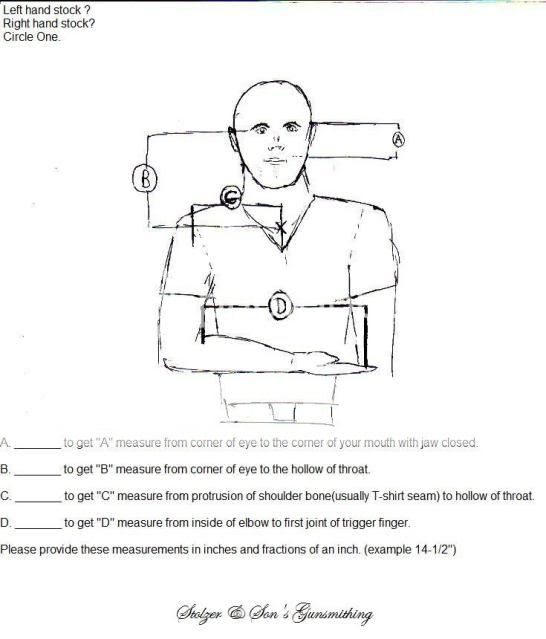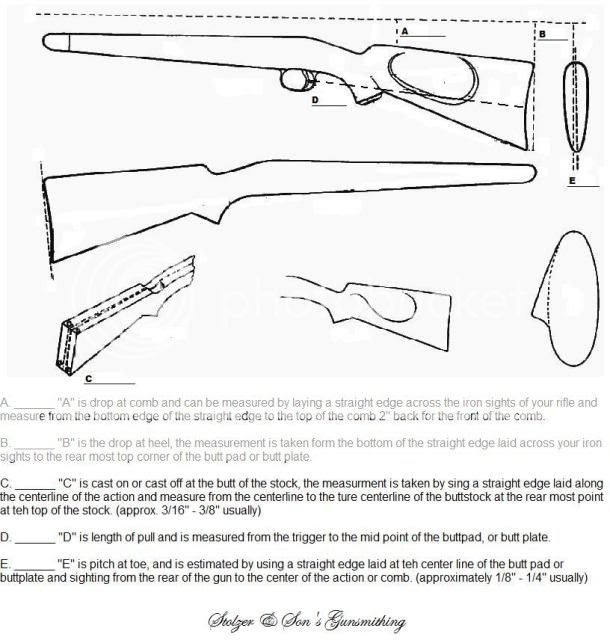The question comes up every so often on various forums about how to measure for stock fit. So I figured it would be a benefit to post a short tutorial on how I get the measurements to custom build a rifle for my customers.
I learned this method from Steve Zihn when I was an apprentice under him. It's based on an old British Method, there are variations of this formula described in W.W. Greener's "The Gun and It's Development", Howe's "Advanced Gunsmithing" and several other books I've read or own. So it's not anything new, and it's certainly not the only way to get these measurements, it's just the method I was taught and use.
I rarely get to meet my customers in person, so I use these worksheets and formulas, along with several questionnaires to fit their rifles. These measurements along with some fine tuning based on the other information have allowed me to build very well fitted rifles for my customers without actually having to measure them in person. Ideally it would be nice if I could actually meet and measure every one in person, using a "try" stock, unfortunately that is cost prohibitive.

"A" is drop at comb. It is measured about 2" back from the nose of the comb.
Take "B" and subtract "A" from it. That's going to be the drop at heel. You will find that most men have the heel above the top of the shoulder, so you can even subtract 3/4" to 1" from this if you like. You'll see how it works out when you transfer these things to paper.
Take "C" and Subtract "B", whatever the difference is divide by 4. That's you cast off.
Take "D" and subtract 1/4" to 1/2" for a warm weather gun and subtract 1/2" to 1" for a cold weather gun. That's your length of pull.

These measurement are not universal to everyone or every style of shooting, they have to be adjusted for the primary type of shooting the rifle will be used for. They also have to be adjusted for the physique of the individual. And they will need to be adjusted for the style, type and period of the rifle being built.
For instance a rifle that is designed for prone shooting will have little to no cast off since the position of the rifle in relation to the shoulder and head are nearly straight up and inline with the sights. As compared to a normal off-hand hunting stance were the rifle is mounted to the front of the shoulder and the head is canted to the cheek/comb. These variations between shooting positions change the measurements some, and the best way to understand the relationship is to actually take a rifle and get in the various positions and see how different the rifle feels as you mount it to your shoulder. Pay attention to hand placement. Relationship of your face and neck to the cheek/comb in each position. Shouldering lots of different guns in lots of different shooting positions will teach you faster than any description I could ever write about what measurements will need to be modified.
The next thing to take into consideration when modifying the initial measurements is the physique of the shooter. One of the questionnaires I send out with the measurement sheets ask questions like:
Muscle tone in the shoulders?
Muscle tone in the Back?
Muscle tone in the chest?
Muscle tone in the abdomen?
It also ask about any physical disabilities that I should be aware of. For instance Neck/spine injuries, back injuries, shoulder injuries, elbow injuries, etc...basically anything that limits the range of movement.
For example if a customer can't tip his head fully to the stock due to a neck or spine injury, the drop of comb, drop of heel and the cast off can be changed as well as the shape and size of the cheek piece can be adjusted to compensate for the limitation. Or if a customer has had the tip of his finger cut off (like my brother-in-law did with his cross-cut saw), the length of trigger pull might have to be changes to compensate.
Muscle tone can have an effect on the measurements as well. For instance large well defined upper body muscles will change the amount of cast off as well as drop at comb and heel and pitch at toe because the muscles protruding will make the rifle mount differently than a less tones individual would shoulder the rifle.
The other thing that will alter these measurements is the type of rifle, the school, and time period that is being built. For instance Pennsylvania, Kentucky, German Jaegers, English stalking rifles, Single shots, Double Rifles, Scoped modern rifle, etc... all have unique design features that are distinct to the school and time frame of the rifle you are building, so these measurements will sometimes have to be modified to accurately represent the type of rifle you are building if historical accuracy or period correct design is part of the build requirements.
This is in no way a comprehensive lesson in stock fitment but it will give you the basics on measurements and the theories behind using those measurements. Most of the changes to the general measurements can't really be described in writing, the best way to learn how a stock needs to be modified for individual fit is hands on, both in mounting many different styles of rifles to your own body, and looking at the way other hold and shoulder rifles in different styles and positions of shooting.
The last thing I should mention is that these measurement for Drop at Comb, Drop at Heel, are all taken from line of sights. So when you start putting these to paper you need to draw your reference line at the height the sights will be at, NOT the top of the barrel, or the Bore line.
I hope this information is helpful.
Colin

